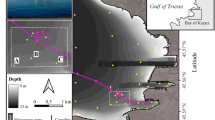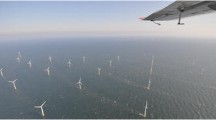Abstract
Purpose
The turbid plumes generated by different types of dredges have specific behaviours and diffusion patterns. The dredging of the Oil Port of Genoa Multedo (Italy) with three different dredges (grab, backhoe and trailing suction hopper) enabled us to study: the physical and hydrodynamic characteristics of the water column of the port and the area just outside it; the characteristics of the turbid plumes; and the different responses of our optical and acoustic instruments.
Materials and methods
In the dredging operations, a vessel equipped with a vertical acoustic Doppler current profiler and a conductivity–temperature–depth probe with a turbidimeter followed the different dredges during their daily operations. Using the acoustic backscatter and turbidity data acquired during the dredging phase, we investigated the turbidity variations caused by the dredging operations to study the evolution of the plume generated by the three different dredges.
Results and discussion
The grab plume was present only on the bottom up to a distance of 50 m from the grab, while at greater distances the turbidity fell to background values. The backhoe plume was present close to the bottom at a distance of 50 m from the dredging and, in the entire water column, at distances of 50–400 and 100 m inside and outside of the port, respectively. The trailing suction hopper dredge plume extended from the surface through the entire water column at distances from the dredging of 400 and 100 m inside and outside of the port, respectively. The highest values were found close to the bottom at distances from the dredging at 50 and 30 m inside and outside of the port, respectively.
Conclusions
The choice of a combined monitoring system is a good practical solution for studying the differences between the turbid plumes created by the three dredging tools (grab, backhoe and trailing suction hopper dredge) under different hydrodynamic conditions. Furthermore, two different types of instrument should give complementary information on different aspects of sediment resuspension during a dredging operation.










Similar content being viewed by others
References
Burt N, Land J, Otten H (2007) Measurement of sediment release from a grab dredge in the River Tees, UK, for the calibration of turbidity prediction software. WODCON 2007 Conference Proceedings, Orlando (FL, USA), pp 1173-1190
Chanson H, Takeuichi M, Trevethan M (2008) Using turbidity and acoustic backscatter intensity as surrogate measures of suspended sediment concentration in a small subtropical estuary. J Environ Manage 88:1406–1416
Cutroneo L, Castellano M, Pieracci A, Povero P, Tucci S, Capello M (2012) The use of a combined monitoring system for following a turbid plume generated by dredging activities in a port. J Soils Sediments 12:797–809
Defendi V, Kovacevic V, Arena F, Zaggia L (2010) Estimating sediment transport from acoustic measurements in the Venice Lagoon inlets. Cont Shelf Res 30:883–893
Fettweis M, Baeye M, Francken F, Lauwaert B, Van den Eynde D, Van Lancker V, Martens C, Michielsen T (2011) Monitoring the effects of disposal of fine sediments from maintenance dredging on suspended particulate matter concentration in the Belgian nearshore area (southern North Sea). Mar Poll Bull 62:258–269
Gartner JW (2004) Estimating suspended solids concentrations from backscatter intensity measured by acoustic Doppler current profiler in San Francisco Bay, California. Mar Geol 211:169–187
Hitchcock DR, Bell S (2004) Physical impacts of marine aggregate dredging on seabed resources in coastal deposits. J Coastal Res 20:101–114
Hoitink AJF, Hoekstra P (2005) Observations of suspended sediment from ADCP and OBS measurements in a mud-dominated environment. Coastal Eng 52:103–118
HR Wallingford Ltd and Dredging Research Ltd (2003) Protocol for the field measurement of sediment release from dredgers. Vereniging van Waterbouwers in Bagger-Kust en Oeverwerken, VBKO. http://www.clu-in.org/download/contaminantfocus/sediments/sediment-release-from-dredgers.pdf
Maynard N, Diaz RJ, Schaffner LC (1990) Effects of hopper dredging and sediment dispersion, Chesapeake Bay. Env Geol 15:31–43
Orpin AR, Ridd PV, Thomas S, Anthony KRN, Marshall P, Oliver J (2004) Natural turbidity variability and weather forecasts in risk management of anthropogenic sediment discharge near sensitive environments. Mar Poll Bull 49:602–612
Palermo MR, Francingues NR, Averett DE (2003) Equipment selection factors for environmental dredging. In: Proceedings of the Western Dredging Association 23rd Technical Conference and 35th Annual Texas A&M Dredging Seminar, June 10-13, Chicago, IL, RE Randell (ed.). CDS Report No. 376. Center for Dredging Studies, Ocean Engineering Program, Civil Engineering Department, Texas A&M University, College Station, TX, USA pp. 342-363
Palermo MR, Francingues NR, Averett DE (2004) Operational characteristics and equipment selection factors for environmental dredging. J Dredg Engineer Western Dredging Assoc Vol 5, No 4
Palermo MR, Francingues NR, Schroeder PR, Estes TO (2006) Guidance for environmental dredging of contaminated sediments, Draft. DOER TRX-X. Prepared for Office of Solid Waste and Emergency Response, Washington, DC, by U.S. Army Engineer Research and Development Center, Vicksburg, MS, USA
Pennekamp JGS, Epskamp RJC, Rosenbrand WF, Mullié A, Wessel GL, Arts T, Deibel IK (1996) Turbidity caused by dredging; viewed in perspective. Terra et Aqua 64:10–17
Sanchez FF (2001) A multimedia model for assessing chemical fate during dredging of contaminated bed-sediment. Louisiana State University, USA, M.S. Thesis
Sanchez FF, Thibodeaux LJ, Valsaraj KT, Reible DD (2002) Multimedia chemical fate model for environmental dredging. Pract Period Hazard Tox. Radioact Waste Manage 6:120–128
Spearman J, Bray RN, Burt TN (2003) Dynamic representation of trailer dredger source terms in plume dispersion modelling. CEDA Dredging Days 2003, Specialist Dredging Techniques, Inspiring Dredging Solutions, Amsterdam. http://www.dredging.org/digitallibrary/Abstract.asp?v0=106
Thevenot MM, Kraus NC (1993) Comparison of acoustical and optical measurements of suspended material in the Chesapeake estuary. J Mar Env Eng 1:65–79
van Rhee C (2002) Modelling the sedimentation process in a trailing suction hopper dredger. Terra et Aqua 86:18–27
Vousdoukas MI, Aleksiadis S, Grenz C, Verney R (2011) Comparisons of acoustic and optical sensors for suspended sediment concentration measurements under non-homogeneous solutions. J Coast Res SI64:160–164
Wang Y, Gao S, Li K (2000) A preliminary study on suspended sediment concentration measurements using an ADCP mounted on a moving vessel. Chin J Oceanol Limnol 18:183–189
Ware S, Bolam SG, Rees HL (2010) Impact and recovery associated with the deposition of capital dredging at UK disposal sites: lessons for future licensing and monitoring. Mar Poll Bull 60:79–90
Acknowledgements
The authors wish to thank Prof. Paul K. Nixon for the English revision of the paper, the Editor-in-Chief and the two anonymous reviewers for their constructive suggestions and comments that greatly improved this manuscript. We also thank the Officers and the Crews of two Italian Coast Guard Vessels (CP 276 and CP 288) for their help during the sea operations. This study was funded by Research Funding of the Genoa Port Authority.
Author information
Authors and Affiliations
Corresponding author
Additional information
Responsible editor: Gijs D. Breedveld
Rights and permissions
About this article
Cite this article
Cutroneo, L., Castellano, M., Ferranti, M.P. et al. Use of optical and acoustic instruments to study the turbid plumes generated by three different types of dredges during dredging activities inside and outside of a port. J Soils Sediments 13, 1645–1654 (2013). https://doi.org/10.1007/s11368-013-0756-5
Received:
Accepted:
Published:
Issue Date:
DOI: https://doi.org/10.1007/s11368-013-0756-5




